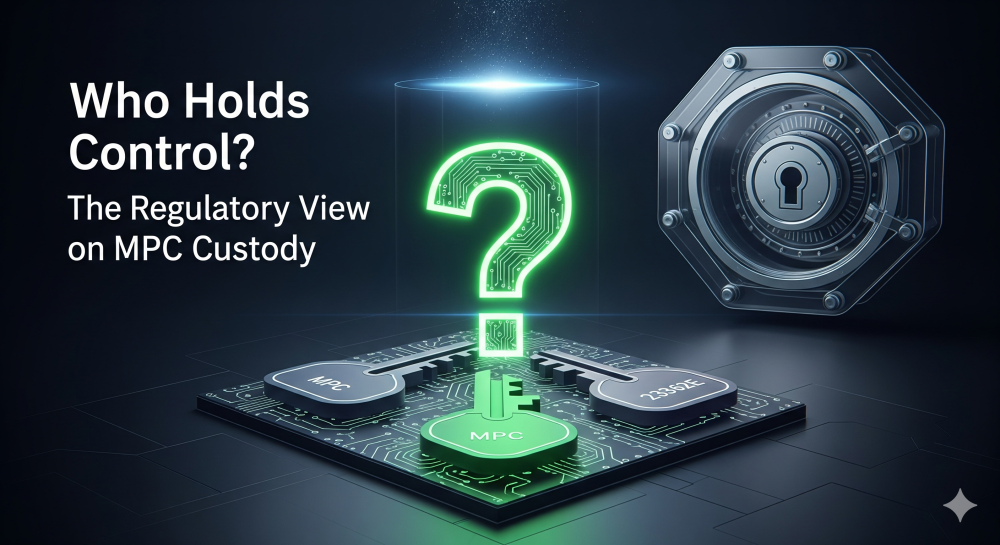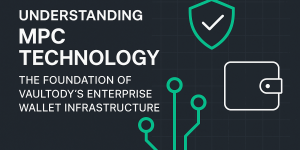Who Holds Control? The Regulatory View on MPC Custody

The Shifting Definition of Custody
In traditional finance, custody has always been straightforward: the custodian physically holds the client’s securities or assets and assumes responsibility for their safekeeping. In digital assets, custody has long been equated with holding the private key to a wallet. Whoever held that key was considered the custodian.
But this model is being disrupted. Multi-Party Computation (MPC) custody has introduced a paradigm where no single party holds the full private key, and transactions are authorized through collaborative computation. This raises a fundamental regulatory question: If no single party ever controls the private key, who actually holds custody?
From Single Keys to Distributed Control
In the early days of crypto custody, solutions revolved around hardware wallets, Hardware Security Modules (HSMs), and cold storage. The private key was generated, stored securely, and used to sign transactions when needed. While effective, this model carried structural weaknesses:
- Single Point of Failure: One compromised key could result in complete loss of funds.
- Operational Fragility: Recovery and rotation procedures were often manual and error-prone.
- Limited Flexibility: Policies such as multi-approval were layered on top rather than built into the cryptography itself.
MPC custody changed this by removing the concept of a single private key entirely. Instead, cryptographic protocols split the signing process across multiple parties, each holding only a share of the secret. Transactions require cooperation, and no party can act alone.
The Regulatory Challenge: Who Holds Control?
For regulators, custody is about more than security — it’s about control and accountability. Legal definitions of custody often boil down to “possession of the private key.” But under MPC:
- No single participant ever holds the complete key.
- Even if one participant is compromised, the protocol prevents unilateral asset movement.
- “Control” becomes collective, enforced through cryptography rather than organizational policy alone.
This raises important questions:
- Is distributed control still custody?
- Which parties are accountable if something goes wrong?
- How should regulators treat cross-border MPC setups?
While these debates are ongoing, one thing is clear: MPC isn’t weakening regulatory control — it’s making it stronger by aligning technical safeguards with the spirit of compliance (segregation of duties, auditability, resilience).
Security Benefits of MPC Custody
At its core, MPC custody provides a stronger security foundation than single-key models. Its main advantages include:
- Threshold Enforcement: Transactions require cooperation of multiple parties or devices, eliminating unilateral risk.
- No Single Point of Failure: Even if one party is compromised, the private key is never exposed.
- Distributed Key Generation (DKG): Keys are generated collaboratively, avoiding vulnerable “key-at-rest” moments.
- Granular Policies: Transaction limits, role-based approvals, and geographic separation can be encoded directly into the cryptographic protocol.
- Auditability: Every signing action can be logged and verified without revealing the underlying secret.
This combination of features makes MPC custody arguably more compliant with regulatory intent than legacy models.
How MPC Is Evolving: Trends to Watch
MPC is not static technology. Over the past three years, cryptographic research and practical implementations have advanced quickly, and several major trends are shaping its future.
1. Asynchronous and Scalable MPC Protocols
Traditional MPC protocols assume synchronous communication and a limited number of participants. Emerging research focuses on asynchronous protocols that can tolerate network delays and scale to larger participant groups without sacrificing security. This is especially relevant for distributed, global custody networks.
2. Hardware-Enhanced MPC (MPC + TEEs/HSMs)
Hybrid models combine MPC with Trusted Execution Environments (TEEs) or Hardware Security Modules (HSMs) to add another layer of defense. While TEEs like Intel SGX have faced lifecycle challenges, the trend toward combining cryptographic and hardware isolation remains strong. Expect increasing use of confidential computing frameworks alongside MPC.
3. Post-Quantum Preparedness
Quantum computing poses a long-term risk to current cryptography. While full-scale quantum attacks are not imminent, regulators and institutions are pressing for post-quantum readiness. Research into post-quantum threshold signatures (lattice-based, hash-based, or isogeny-based) is underway, and MPC will need to adapt to new algorithms with minimal performance trade-offs.
4. Formal Verification and Continuous Auditing
Recent disclosures of vulnerabilities in threshold signature libraries highlight the need for formal verification and continuous security testing. Expect MPC implementations to increasingly rely on provably secure code, formal proofs, and aggressive bug bounty programs.
5. Interoperability and Standards
Bodies like NIST and the IETF are exploring frameworks for threshold cryptography. Over the next few years, expect progress toward standardization of MPC protocols, making it easier for regulators and institutions to evaluate and trust custody solutions.
The Quantum Computing Angle: What Lies Ahead
Quantum computing is often raised as the looming threat to cryptography. While today’s MPC relies on classical primitives like elliptic curve cryptography (ECDSA, EdDSA), quantum algorithms like Shor’s could one day break them.
MPC itself is not a quantum countermeasure — but it is a framework adaptable to post-quantum algorithms. Threshold signatures built on lattice-based or code-based cryptography are being actively researched. When these schemes mature, MPC custody platforms will be able to upgrade cryptographic primitives without abandoning the multiparty architecture.
This agility is critical: institutions don’t want to rebuild their custody solutions every time cryptographic standards change. MPC offers a future-proof architecture for quantum resilience.
The Road Ahead: From Technology to Regulation
For regulators, the core mission remains the same: protect investors, prevent unauthorized transactions, and ensure market stability. The tools are evolving:
- Custody ≠ Key Possession: Regulators will increasingly define custody as control of transaction authority, not key storage.
- Auditability is Key: Regulators will expect cryptographic logs and proofs of policy enforcement.
- Cross-Jurisdiction MPC: Oversight frameworks will need to adapt to distributed architectures spanning multiple countries.
The likely outcome? MPC will be recognized not as a loophole, but as a compliance enabler — a way to meet regulatory intent with cryptographic enforcement stronger than human process controls.
Custody Redefined Through MPC
The definition of custody is shifting from possession to control. With MPC custody, control is distributed, auditable, and cryptographically enforced. Far from complicating regulation, this aligns custody with the goals regulators have always pursued: investor protection, operational resilience, and systemic trust.
Looking forward, expect MPC to evolve in three directions: scalability through asynchronous protocols, resilience through hybrid hardware-cryptography models, and quantum readiness through post-quantum threshold schemes.
The custody debate is no longer about who holds the key. It’s about who holds the authority to act — and how cryptography ensures that authority is exercised safely, compliantly, and securely.




 Login
Login







 Copy link
Copy link